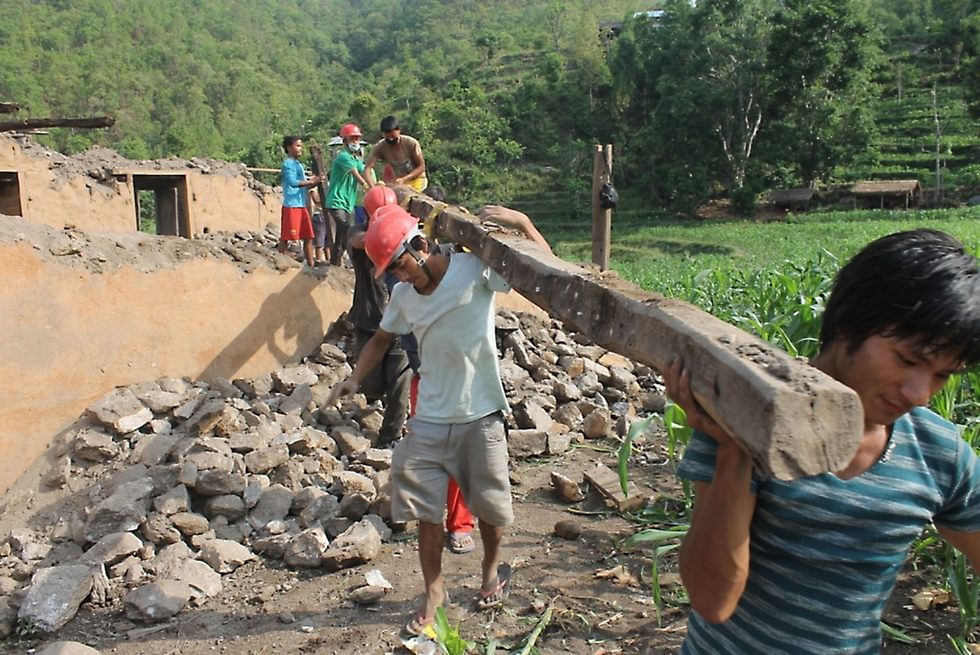Heritage, Continuity, and Nostalgia
From the Series: Aftershocked: Reflections on the 2015 Earthquakes in Nepal
From the Series: Aftershocked: Reflections on the 2015 Earthquakes in Nepal

The political impact of the 2015 earthquakes would have been less significant if their destructive force had not been felt in Kathmandu. The first online photographs to appear on April 25 showed heaps of rubble in the southern quarter of Kathmandu’s Durbar Square. This gave the impression of extensive devastation in the capital and led to an early international media focus on the loss of heritage buildings in the Kathmandu Valley.
The question of whether a major natural disaster necessarily constitutes a watershed in the history of a particular society is salient in the context of contemporary Nepal, given the protracted nature of its postwar political transition. At the time of writing in May 2015, the Nepali media sphere was full of essays by writers who saw the aftermath of the earthquake as an opportunity to accelerate change. While much of this writing focused on the perceived inadequacy of the government’s response and the urgent need for a national political settlement, it was assumed that the restoration of the Kathmandu Valley’s historic built environment would take place without contention, and that the international community would contribute to its costs. However, little discussion was taking place about how the priorities of a national heritage restoration project would be identified.
Edward Simpson (2013, 53) has argued that the aftermath of a disaster is “a product of the longer history of a locality” and it is the aftermath “that may reveal what is dear.” To what extent, then, will the selection of sites and buildings for internationally funded restoration be driven by what is held locally to be most “dear,” and to what extent will it be driven by the evaluations of external donors?
In the immediate aftermath of the first earthquake, a great deal of media coverage was given to the collapse of the Dharhara, the tower built by Bhimsen Thapa in 1825/6 to mark “national independence, unity, Gorkhali pride, progress and advancement” (Tuphan 2015, 33). Architecturally, the tower was unremarkable and its historical and political salience for contemporary Nepal was, at the very least, up for debate. Yet a May 30 report from Jajarkot, Rukum, and Dolpo districts suggested that it was the news of the collapse of the Dharhara that made the greatest impression on the local population, even though many knew it only from photographs. For many Nepalis living outside the Kathmandu Valley the Dharhara is still the preeminent symbol of the city’s identity (Gautam 2015)—perhaps because it is secular, not religious. It was also a major attraction for Nepali visitors to the capital; on April 25, 167 people had bought tickets to climb to its top, and 133 died when it fell.
Architecturally speaking, the Hindu temples of the three palace squares were and are jewels. They are likely to be prioritized for restoration, not least because they attract tourists to Nepal. However, these shrines were established for the benefit of royal patrons, not for the populace at large. Smaller or less centrally located shrines, not to mention Buddhist shrines, play a more important role in the ritual life of the Kathmandu Valley. Indeed, one of the greatest losses has been that of the Machhendranath temple at Bungamati, which is visited by very few foreign tourists. Similarly, the destruction of the Kasthamandapa is mentioned only in passing in most reports, despite the fact that it is reputedly Kathmandu’s oldest building as well as the building from which the city takes its name (providing the logo, incidentally, for the country’s biggest media corporation). It would be unfortunate if competing activisms determined the fate of such buildings.
The April 25 earthquake was a once-in-a-lifetime experience for all but a tiny handful of elderly people in Nepal, and it fell to the Nepali media to remind the public that this had happened before. There was a strong sense of nostalgia in some of these media reports. The year 1934 was recalled as a time of greater Nepali self-reliance: the Newar guthis, which barely exist now, played a leading role in the recovery from the 1934 earthquake; the Rana government made interest-free loans available for the repair of domestic dwellings, the repayment of which Juddha Shamsher waived when he retired from office; senior Ranas donated large sums to the earthquake relief fund, and the government refused offers of international aid (see Joshi 2015; Rana 2013). The 1934 earthquake also brought cultural and technological innovations to Nepal: it was in that earthquake’s aftermath that the people of Kathmandu first ate boiled rice and saw corrugated steel and cement.
Bharat Sharma (2015) asserts that traditional building styles were attuned to the environment of the Valley and to the danger of earthquakes. He suggests that the destruction would have occurred on a lesser scale if the old codes—only building on certain kinds of ground up to a certain height, and using only traditional materials—had been adhered to, and if the old buildings had been properly maintained. This sentiment can be translated into a sociocultural and political message: the destruction of the present might have been less severe if Nepal had not been so alienated from its past. It is essential to observe the interplay of the past and present, and of national and international evaluations of heritage, as the reconstruction effort proceeds.
Gautam, Sarala. 2015. “Dhalyo re ni dharhara.” Kantipur Koseli, May 30.
Joshi, Satyamohan. 2015. “’90 salle nepallai usina chamal, jastapata ra siment diyo.” Himal Khabar Patrika, May 3–9.
Nyaupane, Tuphan. 2015. “Purano shilpa, nayam nirman.” Himal Khabar Patrika, May 3–9.
Rana, Brahma Shumsher Jung Bahadur. 2013. The Great Earthquake in Nepal (1934 A.D.). Translated by Kesar Lall. Kathmandu: Ratna Pustak Bhandar.
Sharma, Bharat. 2015. “Purkhako tyo tatvabodh.” Himal Khabar Patrika, May 10–16.